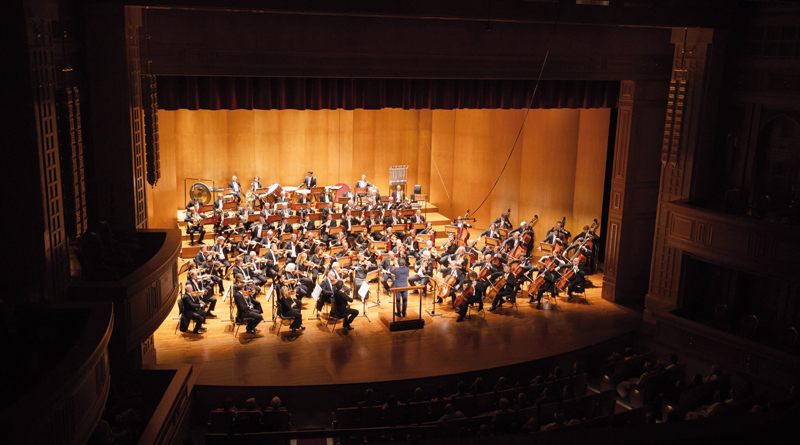

The first of a brace of concerts by Filarmonica Della Scala, conducted by celebrated pianist and internationally acclaimed Korean maestro, Myung-Whun Chung, was held in the theatre of ROHM’s new ‘House of Musical Arts’, opening the 2019/20 season with the first public concert to be held in the new theatre.

Tuesday’s performance was a distinctly Russian Romantic affair. It opened with Rachmaninov’s deliciously filmic 1909 Third Piano Concerto in D minor (used in the soundtrack of the 1996 movie, ‘Shine’). This concerto, considered to be one of the most technically challenging in the repertoire, was performed by the thirty-five-year-old Ukrainian pianist, Alexander Romanovsky. Coming on stage together, Romanovsky took his seat at the Concert Grand while the dapper Chung stood motionless on the podium. The silken opening of the ‘Allegro ma non tanto’ seeped out so imperceptibly it seemed to evolve organically. The intimate acoustics of the House of Musical Arts were instantly apparent, making it almost a chamber music venue where every pin drop is audible – on and off the stage; no need for opera-glasses in this hall! The warm, rich quality of the strings of the Filarmonica della Scala was to be a constant throughout the evening, while the woodwind remained as second fiddle, as it were, in the Rachmaninov.
The impossibly beautiful first piano theme filled the hall effortlessly and Romanovsky who played virtually non-stop for forty minutes never faltered in his communication of the music to the audience. Together with the hundred-strong orchestra, the music swelled and grew to the first lush climax. Cellos and double-basses provided a rhythmic accompaniment under the second theme, played with startling technique. Romanovsky’s dazzling finger work contrasted with the romantic, cathartic harmonies of the ensemble. The breath-taking solo cadenza of the first movement dissolved into a haunting oboe melody (Armel Descotte). The first lyrical, song-like theme from the soloist returned and dissipated the tension into a gentle, subtle conclusion.
The ‘Intermezzo’ opened with woodwind and a beautiful Cor Anglais melody taken up by long, sustained strokes from the Strings. A dreamy solo cadenza (Adagio) developed into a passionate frenzy, giving vent to Romanovsky’s technical capabilities in fast runs over chromatic orchestral chords, growing and swelling in breadth, while the piano carried the thematic material embellished in impossibly intricate light runs, crossed hands, trills, harp-like spreads and full, powerful chords.
The Finale burst across fading horn themes with a fiery fanfare using brass, timps and bass drum, and leading to that famous plaintive melody in the piano, underscored with rich chromatic harmony. The brass interrupted with a percussive dotted rhythm, yet the theme crept back to beguile and seduce. The snare announced the final solo cadenza, rippling the entire length of the keyboard from top to bottom over lush filmic melodies from the strings in a final triumphant climax. The audience, who had sat so attentively, erupted into wild applause and yelps for the young virtuoso – who obliged with a first encore, Liszt’s brilliant ‘Campanello’, showing even more dazzling finger work, if that were possible. Romanovsky concluded his performance with a virtuosic arrangement of Badinerie from Bach’s B minor suite - and a standing ovation.
The second half of the programme was filled with Tchaikovsky’s Symphony No. 6 in B minor, widely known as the Pathétique, this powerful work is considered Tchaikovsky’s greatest symphony. The opening bassoon entry (Gabriele Screpis) emerged out of nothing. It was joined with that iconic La Scala string quality, led by Salvatore Quaranta, and later with viola and horn melodies. The woodwind were now clearer with the whole orchestra filling the diminutive stage without rosters or obstructing piano lid. It was a still, seamless performance with a gorgeous swell of sound in the tutti sections. Clarinettist Fabrizio Meloni concluded the Adagio with an evocative solo theme, and then the ‘Allegro non troppo’ cut in, attacca. A signature Tchaikovsky tutti including piercing trumpets and trombones hailed a Friar Lawrence-like theme in the Horns. Timpani rolls sounded a death-knell in this unquestionably programmatic symphony, and the section ended with added tubas in a big brass sound. Maestro Chung, normally minimalist and understated in style, drew huge movements conducting such climactic sections.
The ‘Allegro con grazia’ opened with a beautiful love-theme frim the strings in warm, velvet colours until brass themes over pizzicato strings faded away, dying ‘al niente’ at the end of the section. The exciting dance which followed, the ‘waltz with a limp’ in 5/8 suggested an intoxicated ballroom scene with its uneven cello strokes. It was followed by a triumphant march; a dialogue between strings and brass with interruptions from the piccolo, oboes and bassoons. The timps, bass drum and cymbals brought this great ‘Allegro Molto Vivace’ tutti section to a rousingly triumphant climax.
Tchaikovsky’s life was characterised by periods of despair and depression and he died nine days after he completed this final work. Unusually the ‘Symphonie Pathétique’ ends with the slow movement, ‘Adagio lamentoso’, and this unfolds with bassoon themes of gloom and defeat. The Filarmonica della Scala excelled in clarity, precision of articulation, and incredible unison in their string playing. The cellos and basses veritably relished the close of the symphony with their lush romantic final melody. The trombone and tuba quartet was perfectly balanced and eerily dramatic as the horns pulsated like heartbeats, and the movement faded to utter despair, al niente.
The atmosphere in the chamber was electric; the proximity of these superb musicians made for a spine-chilling intimacy, and one could only dare anticipate what emotions the second concert the following evening would elicit.
Photos by KHALID AL BUSAIDY
Oman Observer is now on the WhatsApp channel. Click here



